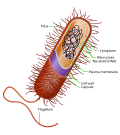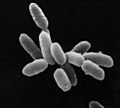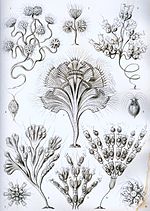include the earlier two-empire system (with the empires Prokaryota and Eukaryota), and the eocyte hypothesis (with two domains of Bacteria and Archaea...
12 KB (1,294 words) - 09:52, 11 June 2024
Excavata is an extensive and diverse but paraphyletic group of unicellular Eukaryota. The group was first suggested by Simpson and Patterson in 1999 and the...
20 KB (1,637 words) - 04:44, 22 April 2024
Archaebacteria). Organisms with nuclei are placed in a third domain, Eukaryota. Prokaryotes evolved before eukaryotes, and lack nuclei, mitochondria...
44 KB (4,770 words) - 02:48, 26 June 2024
Kingdom (biology) (redirect from Kingdoms of the Eukaryota)
later be expanded to the three-domain system of Archaea, Bacteria, and Eukaryota. The differences between fungi and other organisms regarded as plants...
74 KB (4,803 words) - 10:40, 17 June 2024
(or DRIP clade, or Mesomycetozoea) are a small group of Opisthokonta in Eukaryota (formerly protists), mostly parasites of fish and other animals. They...
9 KB (780 words) - 23:14, 30 June 2024
2018. Retrieved 28 September 2017. Lineage( full ) cellular organisms; Eukaryota; Opisthokonta; Metazoa; Eumetazoa; Bilateria; Protostomia; Ecdysozoa;...
6 KB (535 words) - 22:52, 11 May 2024
single kingdom Bacteria (a kingdom also sometimes called Monera), with the Eukaryota for all organisms whose cells contain a nucleus. A small number of scientists...
69 KB (6,804 words) - 10:43, 16 June 2024
classification of Anas platyrhynchos (the mallard duck) with 40 clades from Eukaryota down by following this Wikispecies link and clicking on "Expand". The...
17 KB (1,779 words) - 01:25, 30 June 2024
the International Botanical Congress. Kingdom Plantae belongs to Domain Eukaryota and is broken down recursively until each species is separately classified...
137 KB (14,760 words) - 23:55, 11 July 2024
that the Eukaryota are deep within Asgard, as sister of Hodarchaeales within the Heimdallarchaeia. In the depicted scenario, the Eukaryota are deep in...
33 KB (2,833 words) - 03:42, 1 July 2024
unique properties separating them from the other two domains, Bacteria and Eukaryota. Archaea are further divided into multiple recognized phyla. Classification...
156 KB (16,511 words) - 21:20, 13 July 2024
Bifidobacterium animalis which is present in the human large intestine Eukaryota are organisms whose cells contain a membrane-bound nucleus. They include...
15 KB (1,602 words) - 17:54, 14 June 2024
proposed clade of biological life composed of the two domains Archaea and Eukaryota, coined by Thomas Cavalier-Smith in 2002. Its name reflects the hypothesis...
11 KB (1,137 words) - 05:42, 11 February 2024
Paratrimastix, F), parabasalids (trichomonads, P/S, hypermastigids, S) Eukaryota incertae sedis : haptophytes (F/A), cryptophytes (F/A), kathablepharids...
13 KB (1,350 words) - 03:43, 17 June 2024
Archaea and Bacteria, only contain microorganisms. The third domain Eukaryota includes all multicellular organisms as well as many unicellular protists...
74 KB (7,743 words) - 10:34, 13 July 2024
or habitat conditions. Fungi are the only group of organisms in the Eukaryota domain that can survive at temperature ranges of 50–60 °C. Thermophilic...
12 KB (1,260 words) - 21:27, 24 June 2024
unique properties separating them from the other two domains, Bacteria and Eukaryota. Archaea are further divided into multiple recognized phyla. Archaea and...
132 KB (13,750 words) - 04:27, 23 June 2024
Smallest organisms (section Eukaryotes (Eukaryota))
The smallest organisms found on Earth can be determined according to various aspects of organism size, including volume, mass, height, length, or genome...
46 KB (5,145 words) - 13:36, 3 July 2024
antiprotozoal when they really mean anti-protist. Protists are a supercategory of eukaryota which includes protozoa. The mechanisms of antiprotozoal drugs differ...
5 KB (507 words) - 23:48, 21 October 2023
bacterium from the genus of Neptunomonas which has been isolated from the eukaryota Symbiodinium from Puerto Rico. Parte, A.C. "Neptunomonas". LPSN. "Neptunomonas...
2 KB (138 words) - 16:43, 17 April 2024
Gaoyuzhuang Formation of China. It has been tentatively placed inside Eukaryota due to its complexity and size, alongside other fossils from the formation...
2 KB (187 words) - 21:35, 21 June 2024
soaring over southern Peru's Colca Canyon Scientific classification Domain: Eukaryota Kingdom: Animalia Phylum: Chordata Class: Aves Order: Cathartiformes Family:...
13 KB (1,450 words) - 16:43, 9 July 2024
modern life-forms between Bacteria and a clade formed by Archaea and Eukaryota in the phylogenetic tree of life. It lived over 4 Gya. A minority of studies...
203 KB (21,018 words) - 20:00, 11 July 2024
(sometimes all) were included in Protista, later also abandoned in favour of Eukaryota. However, as a legacy of the older plant life scheme, some groups that...
91 KB (10,509 words) - 15:43, 22 May 2024
archaea and eukaryota, such as the RecA protein in bacteria, the RadA protein in archaea, and the Rad51 and Dmc1 proteins in eukaryota. The functionality...
61 KB (6,496 words) - 09:07, 13 June 2024
Occurrence of amino acids is based on 135 Archaea, 3775 Bacteria, 614 Eukaryota proteomes and human proteome (21 006 proteins) respectively. In mass spectrometry...
38 KB (1,631 words) - 11:23, 12 April 2024
three domains: Bacteria and Archaea, which contain the prokaryotes, and Eukaryota, comprising the remaining forms. These arrangements should not be seen...
22 KB (2,447 words) - 21:49, 28 June 2024
three-domain system. It classified cellular life into Prokaryota and Eukaryota as either "empires" or "superkingdoms". When the three-domain system was...
3 KB (838 words) - 22:08, 9 June 2024
phosphatase activity. This enzyme is missing in most other Bacteria and in Eukaryota, and is heat-stabile even in mesophilic marine Crenarchaeota". It is proposed...
33 KB (3,705 words) - 17:59, 8 June 2024






















